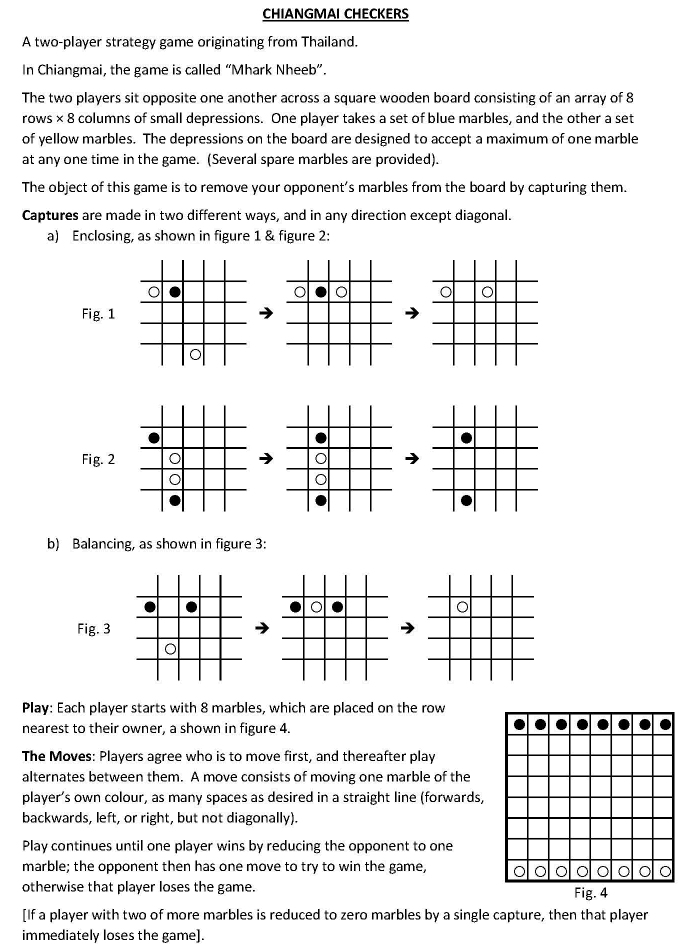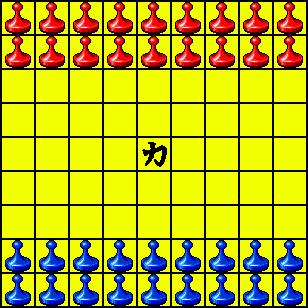HASAMI SHOGI
Traditional Japan
The word Hasami means sandwiching. The game is played
on a Shogi board (9x9 squares). Each player has 18 stones as shown in the initial setup.
 |
MOVE
- All stones move as the chess Rook.
 |
CAPTURING - .When a player
sandwiches opponent's piece(s) by two of his own pieces, he captures the sandwiched
piece(s). A player can sandwich horizontally and vertically, but NOT diagonally.
 |
GOAL
- A player wins when the opponent has just one stone left.
 |
EDGES
- (optional rule) A stone at the edge of the board can be taken by two
adjacent pieces; i.e., a stone at a1 can be captured by two stones at a2 and b1.
|
| | |
|
This type of capture is called custodian
capture.
|
|
An example
If it's Black turn, he may capture the white
central stones by moving to [1]. The same happens to White, if he moves into [2].
|
There is an hexagonal variant for Hasami Shogi, called Take
 (invented at 1984 by Mike
Woods), which is probably a better game.
(invented at 1984 by Mike
Woods), which is probably a better game.
Curiously, there is an old Roman game, called
Latrunculi
seemly very similar to Hasami Shogi, but the exact rules are not known.
A similar game is Mak-yek
 played in Siam (and
Malaysia under the name Apit-sodok) with the same goal, on the same
board, but the 18 stones of each player are placed on the first and third
row. The moves are the same, but the capture is custodian and also by
intervention. Intervention capture is the opposite of custodian. If a stone
moves between two enemy stones, it captures both stones.
played in Siam (and
Malaysia under the name Apit-sodok) with the same goal, on the same
board, but the 18 stones of each player are placed on the first and third
row. The moves are the same, but the capture is custodian and also by
intervention. Intervention capture is the opposite of custodian. If a stone
moves between two enemy stones, it captures both stones.
Another traditional game is Chiangmai Checkers from Thailand,
where it is called Mhark Nheeb,

Chikara
 is a 2001 game
by Chris Huntoon which "is an attempt to 'modernize' Hasami-Shogi and make it
more appealing and challenging to contemporary players".
is a 2001 game
by Chris Huntoon which "is an attempt to 'modernize' Hasami-Shogi and make it
more appealing and challenging to contemporary players".

The rules:
Object: Get 5 pawns in a line in any direction, within
the 5 rows on your opponent's side of the board. A player may also win by
reducing their opponent's pieces to 4 or less, thus making it impossible for
their opponent to form a line of 5.
The pieces slide like Queens in Chess, i.e. any number of
empty spaces up, down, left, right, or diagonally. A piece can also make a
single jump in any direction over another piece of either color that is
adjacent to it. The jumping piece lands on the other side. This is not a
capture. The only capturing is achieved by sandwiching your opponent's
pieces between yours along a row, column or diagonal. This is similar to
Reversi, except that the pieces are removed from the board instead of
flipped.